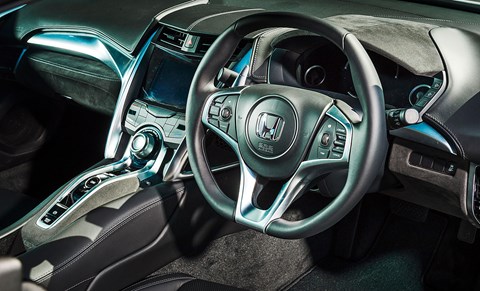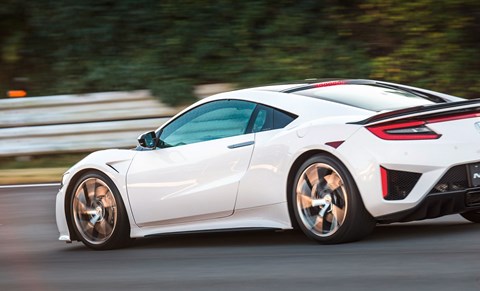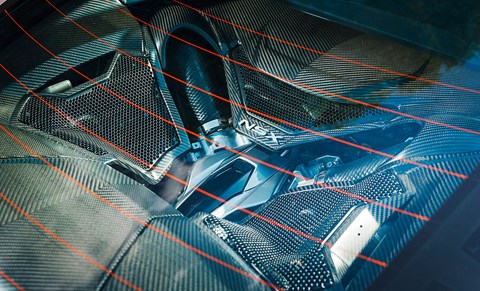► 2016’s most wanted cars: #9 Honda NSX
► A famous return for the NSX, another gamechanger?
► Three electric motors rack up weight to 1725kg
The name may be the same and the remit similar – an everyday supercar with a road focus – but that’s where the similarities end, as they must for two cars developed a quarter of a century apart. NSX 2.0 is a hybrid two-seat sports car set to cost in the region of £120,000. The bald figures are 565bhp from a car weighing 1725kg, a top speed of 191mph and a 0-62mph time of less than 3 seconds. Unlike the (less expensive) BMW i8 and (significantly more expensive) Porsche 918, the NSX is not a plug-in hybrid. The battery is small (1kWh for an EV range of about a mile and a half) and, like the three e-motors it feeds, exists only to enhance performance.
Aluminium with strategic use of carbonfibre (a single large floor panel) and high-strength steel, Honda claims the car’s structure sets class standards for rigidity, but then the NSX has been so long in development it’s been variously benchmarked against the (now defunct) Ferrari 458 Italia and the long-in-the-tooth Porsche 911 Turbo. Suspension is by double wishbones at the front and multi-link at the rear, controlled by magnetic dampers. Honda’s worked to reduce the front motors’ corrupting effect on the steering through clever geometry and double ball-joints on the lower suspension arms.
The engine’s a 3.5-litre, dry-sumped twin-turbocharged V6. There’s variable timing on the intake and exhaust cams but full VTEC, with variable lift, does not feature. With twin turbos and e-boosting (the 109lb ft rear e-motor works to deliver torque where the single-scroll turbos fall short), Honda deemed the system surplus to requirements. The engine drives the rear wheels through a home-grown twin-clutch 9-speed DCT transmission, with the e-motors calibrated to smooth the dips between gears with momentary power surges – all part of the NSX’s ‘zero-delay’ philosophy.

If the NSX sounds like a complicated car – and its spec sheet, prolonged gestation and sheer weight would suggest it is – that feeling lasts only as long as opening the door and sliding over the slim sill into the low-slung but comfortable cockpit. Take a moment to appreciate the panoramic forward visibility – low dashboard, slim A-pillars – start the engine (if it stays silent you’re in EV-biased Quiet mode), grasp the oddly shaped wheel (pronounced bulges where you grasp it) and go.
For a car weighing more than 1700kg (a gluttonous 300kg more than a McLaren 570S), the NSX makes a good fist of feeling fast. ‘Zero delay’ might be a slight exaggeration but with the hybrid drivetrain delivering additional torque and all-wheel-drive traction, the Honda launches with a refined violence that can make you feel mildly unwell. There’s no need for any throttle modulation – just put your foot down and the low-slung coupe hooks up without a flicker of the traction control and gathers speed with a heavy insistence. It’s a job to keep the thing in gears, so closely stacked are the ratios. After the initial getaway that ferocity does bleed away as the car’s weight and the e-motors’ ability to help diminishes, but this remains an effortlessly fast car.
A shame then the gearbox itself isn’t nicer to use, and that the cacophony of acceleration is both a little ugly in note and dislocated from what the engine’s actually doing. The cheap-feeling shift paddles pull home with a disappointing ‘clack’ and offer little of the McLaren unit’s feel-good tactility. And while the exhaust note is nothing more than a muted if potent purr in normal driving, twirl the drive mode selector around to Sport or Sport+ and the racket from the artificial acoustics is less than spine tingling.

Take a moment to get the measure of the steering. The system is neither hefty and nuanced like a Porsche 911 GT3’s, nor exhilarating in its speed and responsiveness like a Ferrari 488 GTB. Deliberately so, argues project leader Ted Klaus – ‘We wanted driver confidence and a sense of complete control.’ True enough as you build speed and slide into Sport+ (the third of four modes, which ramp up from Quiet to Track) you grow to admire the accuracy and reassuring paucity of slack in the NSX’s steering. Response to your demands is immediate and accurate, and it’s during these tentative enquiries that the first flickers of chassis magic make themselves known. At speed the car changes direction with an almost surreal ease, as if the physics that normally interfere with doing so have been subtly but tangibly re-written in your favour.
Soon you long to get stuck into a meaty complex of corners, happy that you have the car beneath you to monster them. Here the NSX’s mixed-media powertrain promises unique advantages, being able to trim the force at each front wheel for an ideal cornering attitude without drive-sapping applications of the brakes. At the wheel you’re vaguely aware of the car’s intelligent powertrain at work but mainly there’s just a sense of neat, composed togetherness, the Honda driving where you expect a slide.
Ultimately the NSX is inseparable from its hybrid drivetrain. Without it the Honda would be a lighter, less powerful, less complex car, and one closer in spirit to its namesake. But Honda, perhaps more than any other manufacturer, is a believer in progress through technology. Do the advantages of the NSX’s hybrid powertrain negate the weight penalty? Given the car’s real-world remit, Klaus is adamant that they do, and the way it powers out of tighter corners, shrugging off early stabs of throttle and translating them into big corner-exit speeds, would certainly seem to back him up, as would the car’s eerie sense of agility without the instability. But still the NSX can’t out-think 1725kg.

An extended road drive – as opposed to this all-too-brief first encounter – will answer a lot of questions, and perhaps banish the lingering fear that this car just doesn’t feel as special as it should. Job done, Honda argues, if ‘special’ means obtrusive NVH, tiresome steering and a chassis prone to spats of oversteer. This is an everyday supercar, remember, but surely the game’s moved on – what’s not everyday about an R8, 570S (okay, the doors perhaps) and the 911 Turbo? Technically fascinating, impressively resolved and unfeasibly easy to drive fast, if the NSX has a failing it’s that its road-biased remit has left it feeling a little aloof. The original’s subtle brilliance emerged with time and miles. Perhaps it’ll be the same story with its complex, enigmatic and fiercely ambitious successor.
The specs: Honda NSX
Price: £120,000 (est)
Engine: 3493cc twin-turbocharged V6 plus 3 x e-motors, 565bhp @ 6500rpm-7500rpm, 476lb ft @ 2000rpm
Transmission: Nine-speed paddleshift DCT, four-wheel drive
Performance: Sub 3sec 0-62mph, 191mph, 30mpg (est), n/a g/km CO2
Weight: 1725kg
Length/width/height: 4470/1940 /1215mm
On sale: Now
Rating: ****